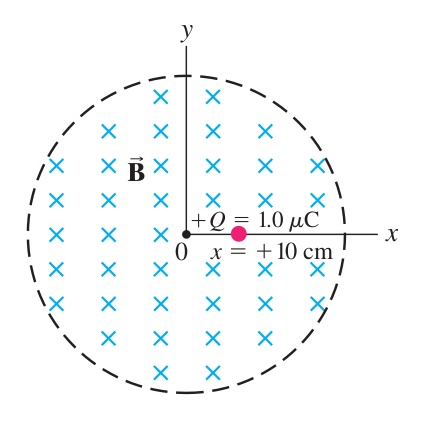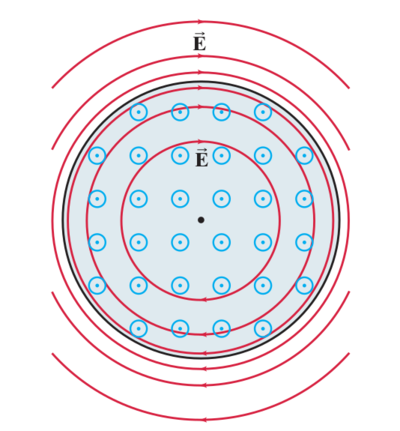Difference between revisions of "Exercise 120519"
(Created page with "==Problem 1== 500px|center|Charge and changing magnetic field In a circular region, there is a uniform magnetic field <math>\vec{B}</math>...") |
|||
| Line 1: | Line 1: | ||
| − | ==Problem 1== | + | ==Problem 1 (on demand)== |
[[File:Exercise120519Problem1q.png|500px|center|Charge and changing magnetic field]] | [[File:Exercise120519Problem1q.png|500px|center|Charge and changing magnetic field]] | ||
In a circular region, there is a uniform magnetic field <math>\vec{B}</math> pointing into the page. An xy coordinate system has its origin at the circular region’s center. A free positive point charge <math>Q = +1.0 \mu</math>C is initially at rest at a position <math>x = +10</math> cm on the x axis. If the magnitude of the magnetic field is now decreased at a rate of <math>-0.10</math> T/s, what force (magnitude and direction) will act on <math>+Q</math>? | In a circular region, there is a uniform magnetic field <math>\vec{B}</math> pointing into the page. An xy coordinate system has its origin at the circular region’s center. A free positive point charge <math>Q = +1.0 \mu</math>C is initially at rest at a position <math>x = +10</math> cm on the x axis. If the magnitude of the magnetic field is now decreased at a rate of <math>-0.10</math> T/s, what force (magnitude and direction) will act on <math>+Q</math>? | ||
| + | |||
| + | Is this force conservative? | ||
| + | |||
| + | ==Solution== | ||
| + | |||
| + | [[File:Exercise120519Problem1s1.png|400px|center|Charge and changing magnetic field]] | ||
| + | |||
| + | Remember the Lenz's law | ||
| + | |||
| + | <math> \mathcal{E}=-\frac{d\Phi_B}{dt}</math> | ||
| + | |||
| + | Combining this with the definition of emf, <math>V_{ab}=\int_a^b\vec{E}\cdot d\vec{l}</math> | ||
| + | |||
| + | <math>\oint \vec{E}\cdot d\vec{l} =-\frac{d\Phi_B}{dt}</math> | ||
| + | |||
| + | i.e. a changing magnetic field produces an electric field. | ||
| + | |||
| + | Choose a circular path centered at the origin with radius 10 cm. By symmetry the electric field is uniform along this path and is parallel to the path. We then use Eq. 29-8 to calculate the electric field at each point on this path. From the electric field we calculate the force on the charged particle. | ||
| + | |||
| + | <math>\oint \vec{E}\cdot d\vec{l}=E(2\pi r)=-\frac{d\Phi_B}{dt}=-(\pi r^2 )\frac{dB}{dt}</math> | ||
| + | |||
| + | <math>F=QE=-Q\frac{r}{2}\frac{dB}{dt}=-(1.0\times 10^{-6} \textrm{ C})\frac{0.10\textrm{ m}}{2}(-0.10\textrm{ T/s})=50 \textrm{ N} </math> | ||
| + | |||
| + | Since the magnetic field points into the page and is decreasing, Lenz’s law tells us that an induced | ||
| + | circular current centered at the origin would flow in the clockwise direction. Therefore, the initial force on | ||
| + | a positive charge along the positive x-axis would be down, or in the <math>-\hat{j}</math> direction. | ||
| + | |||
| + | In the electrostatic case, the potential difference between two points is | ||
| + | |||
| + | <math>V_{ba}=V_b - V_a=-\int_a^b\vec{E}\cdot d\vec{l}</math> | ||
| + | |||
| + | In the case of a circle since the start and end points are the same, | ||
| + | |||
| + | <math>\oint \vec{E}\cdot d\vec{l}=0</math> | ||
| + | |||
| + | the relation above, <math>\oint \vec{E}\cdot d\vec{l}=0</math>, tells us that the work done per unit charge around any | ||
| + | closed path is zero (or the work done between any two points is independent of path), which is a property only of a conservative force. But in the nonelectrostatic case, when the electric field is produced by a changing magnetic field, the integral around a closed path is '''not zero''' | ||
| + | |||
| + | <math>\oint \vec{E}\cdot d\vec{l} =-\frac{d\Phi_B}{dt}</math> | ||
| + | |||
| + | thus this force is not conservative. | ||
Revision as of 01:15, 13 May 2019
Problem 1 (on demand)
In a circular region, there is a uniform magnetic field pointing into the page. An xy coordinate system has its origin at the circular region’s center. A free positive point charge C is initially at rest at a position cm on the x axis. If the magnitude of the magnetic field is now decreased at a rate of T/s, what force (magnitude and direction) will act on ?
Is this force conservative?
Solution
Remember the Lenz's law
Combining this with the definition of emf,
i.e. a changing magnetic field produces an electric field.
Choose a circular path centered at the origin with radius 10 cm. By symmetry the electric field is uniform along this path and is parallel to the path. We then use Eq. 29-8 to calculate the electric field at each point on this path. From the electric field we calculate the force on the charged particle.
Since the magnetic field points into the page and is decreasing, Lenz’s law tells us that an induced circular current centered at the origin would flow in the clockwise direction. Therefore, the initial force on a positive charge along the positive x-axis would be down, or in the direction.
In the electrostatic case, the potential difference between two points is
In the case of a circle since the start and end points are the same,
the relation above, , tells us that the work done per unit charge around any closed path is zero (or the work done between any two points is independent of path), which is a property only of a conservative force. But in the nonelectrostatic case, when the electric field is produced by a changing magnetic field, the integral around a closed path is not zero
thus this force is not conservative.














